KINGS of THRACE - Odrysian
Saratokos. Circa 444-424 B.C.
Silver Obol 9mm (0.81 grams)
Reference: Topalov 69; Peykov Type I, B0360; Peter p. 100, n. 491
Certification: NGC Ancients VF 4281368-011
Young male head right.
Σ-A, Grape bunch on vine; all within incuse square. You are bidding on the exact item pictured, provided with a Certificate of Authenticity and Lifetime Guarantee of Authenticity.
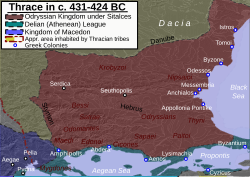 The Odrysian Kingdom (Ancient Greek: Βασίλειον Ὀδρυσῶν, Latin: Regnum Odrysium) was a state union of over 40 Thracian tribes and 22 kingdoms that existed between the 5th century BC and the 1st century AD. It consisted mainly of present-day Bulgaria, spreading to parts of Northern Dobruja, parts of Northern Greece and parts of modern-day European Turkey. The Odrysian Kingdom (Ancient Greek: Βασίλειον Ὀδρυσῶν, Latin: Regnum Odrysium) was a state union of over 40 Thracian tribes and 22 kingdoms that existed between the 5th century BC and the 1st century AD. It consisted mainly of present-day Bulgaria, spreading to parts of Northern Dobruja, parts of Northern Greece and parts of modern-day European Turkey.
It is suggested that the kingdom had no capital. Instead, the kings may have moved between residences. A capital was the city of Odryssa (assumed to be Uscudama, modern Edirne), as inscribed on coins. Another royal residence believed to have been constructed by Cotys I (383-358 BC) is in the village of Starosel, while in 315 BC Seuthopolis was built as a capital. An early capital was Vize. The kingdom broke up and Kabyle was a co-capital by the end of the 4th century BCE. The Odrysians (Odrysae or Odrusai, Ancient Greek: "Οδρύσαι") were one of the most powerful Thracian tribes that dwelled in the plain of the Hebrus river. This would place the tribe in the modern border area between Southeastern Bulgaria, Northeastern Greece and European Turkey, centered around the city of Edirne. The river Artescus passed through their land as well. Xenophon writes that the Odrysians held horse races and drank large amounts of wine after the burial of their dead warriors. Thucydides writes on their custom, practised by most Thracians, of giving gifts for getting things done, which was refuted by Heraclides. Herodotus was the first writer to mention the Odrysae. Thrace had been part of the Persian empire since 516 BC during the rule of Darius the Great, and was re-subjugated by Mardonius in 492 BC. During Persian rule, it made part of the Skudra satrapy (province). Parts were occupied by Scythians and Greek colonists earlier besides the numerous later invasions. The Odrysian state was the first Thracian kingdom that acquired power in the region, by the unification of many Thracian tribes under a single ruler, King Teres, probably in the 470s BC after the Persian defeat in Greece. Initially, during the reign of Teres or Sitalces the state was at its zenith and extended from the Black Sea to the east, Danube to the north, the region populated with the tribe called Triballi to the north-west, and the basin of the river Strymon to the south-west and towards the Aegean. Later, its extent changed from present-day Bulgaria, Turkish Thrace and Greece between the Hebrus and the Strymon (except for a coastal strip that was occupied by Greek cities. Sovereignty was never exercised over all of its lands as it varied in relation to tribal politics. Historian Z.H. Archibald writes: The Odrysians created the first state entity which superseded the tribal system in the east Balkan peninsula. Their kings were usually known to the outside world as kings of Thrace, although their power did not extend by any means to all Thracian tribes. Even within the confines of their kingdom the nature of royal power remained fluid, its definition subject to the dictates of geography, social relationships, and circumstance
This large territory was populated with a number of Thracian and Daco-Moesian tribes that united under the reign of a common ruler, and began to implement common internal and external policies. These were favorable conditions for overcoming the tribal divisions, which could lead gradually to the formation of a more stable ethnic community. This was not realised and the period of power of the Odrysian kingdom was brief. Despite the attempts of the Odrysian kings to bolster their central power, the separatist tendencies were very strong. Odrysian military strength was based on intra-tribal elites making the kingdom prone to fragmentation. Some tribes were rioting constantly and tried to separate, while others remained outside the borders of the kingdom. At the end of the 5th and the beginning of the 4th century BC, as a result of conflicts, the Odrysian kingdom split into three parts. The political and military decline continued, while Macedonia was rising as a dangerous and ambitious neighbour. According to the Greek historians Herodotus and Thucydides, a royal dynasty emerged from among the Odrysian tribe in Thrace around the end of the 5th century BC, which came to dominate much of the area and peoples between the Danube and the Aegean for the next century. Later writers, royal coin issues, and inscriptions indicate the survival of this dynasty into the early 1st century AD, although its overt political influence declined progressively first under Persian, Macedonian, later Roman, encroachment. Despite their demise, the period of Odrysian rule was of decisive importance for the future character of south-eastern Europe, under the Roman Empire and beyond. Teres' son, Sitalces, proved to be a good military leader, forcing the tribes that defected the alliance to acknowledge his sovereignty. The rich state that spread from the Danube to the Aegean built roads to develop trade and built a powerful army. In 429 BC, Sitalces allied himself with the Athenians and organized a massive campaign against the Macedonians, with a vast army from independent Thracian and Paeonian tribes. According to Thucydides, it included as many as 150,000 men, but was obliged to retire through the failure of provisions, and the coming winter. Greek as a lingua france had been spoken at least by some members of the royal household in the fifth century and became the language of administrators, the Greek alphabet was adopted for a new Thracian script despite Thrace being home only to non-Greek-speaking tribes. After the kingdom had split itself in three semi-independent kingdoms Philip II of Macedon invaded and conquered much of Thrace. Some Odrysian kings and other Thracian tribes were submitted and paid taxes at times during different periods to Philip II, Alexander the Great and Philip V. Two of the three kingdoms were forced into vassal status by Philip II in 352 BC, while in 342-341 BC he conquered the Odrysian heartland deposing reigning kings or rebelled vassals. Nevertheless, Seuthes III (341-300 BC) had survived the expansion of Philip, maintaining continuity of the kingdom probably only as a client on a power-sharing basis with the appointed Macedonian satrap of Thrace Lysimachus in 323 BC. But Seuthes had warred often against Lysimachus and set the capital at Seuthopolis from 320 BC until it was sacked by the Celts in 281 BC. By 212 BC an army led by an Odrysian king Pleuratus destroyed the Celtic kingdom and its capital Tylis. The Odrysian kingdom had maintained continuity with its own kings, but broken up into several kingdoms (including Canite and Odrissae) by the early second century BC, until succumbing to complete Roman conquest in 146 BC. In 100 BC a Thracian kingdom was resotred, possibly by a son of Beithys, one of the last kings of the Odrissae, it is not clear if it was a vassal of Rome or entirely independent. Several years later, some Thracians and Celts overran the southern Balkans, Epirus, Dalmatia and northern Greece, and penetrated the Peloponnese. A kingdom of another Odrysian bloodline had re-emerged in 55 BC (Sapei) and by 30 BC it conquered or otherwise controlled the other Odrysian kingdom (Antaea). Although it became a Roman proxy soon afterward, along with other Thracian tribes. By 11 BC the uncle of the Roman emperor Augustus was the Odrysian king, easing the gradual Romanization of the region. The Odrysian king was murdered by his wife and his kingdom was completely subjected to Rome in 46 AD.
|
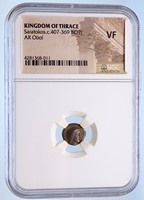
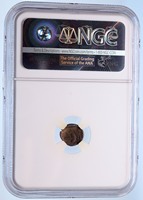
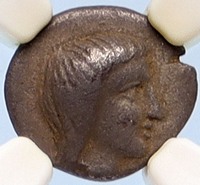
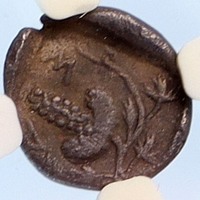
 The Odrysian Kingdom (Ancient Greek: Βασίλειον Ὀδρυσῶν, Latin: Regnum Odrysium) was a state union of over 40 Thracian tribes and 22 kingdoms that existed between the 5th century BC and the 1st century AD. It consisted mainly of present-day Bulgaria, spreading to parts of Northern Dobruja, parts of Northern Greece and parts of modern-day European Turkey.
The Odrysian Kingdom (Ancient Greek: Βασίλειον Ὀδρυσῶν, Latin: Regnum Odrysium) was a state union of over 40 Thracian tribes and 22 kingdoms that existed between the 5th century BC and the 1st century AD. It consisted mainly of present-day Bulgaria, spreading to parts of Northern Dobruja, parts of Northern Greece and parts of modern-day European Turkey.
